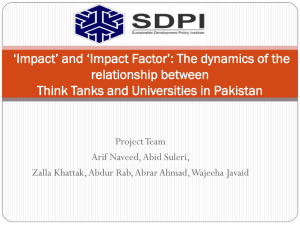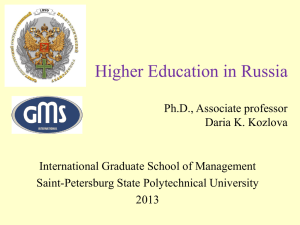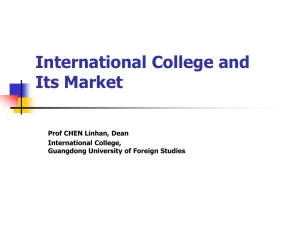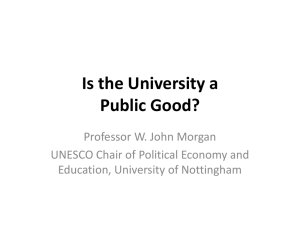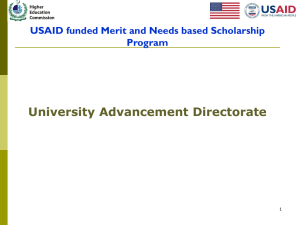Research findings from Latin America
advertisement
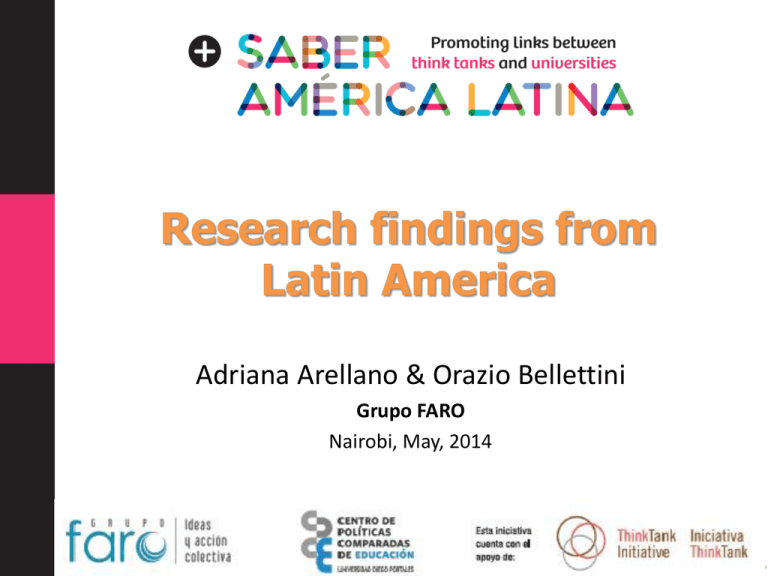
Adriana Arellano & Orazio Bellettini Grupo FARO Nairobi, May, 2014 Outline 1. Knowledge production in Latin America 2. About the study – – – – – 3. 4. 5. 6. Objective Team Approach Methodology Outputs Findings Preliminary conclusions Policy recommendations Future research Universities in Top 100 Patents Universities in Top 500 Citing of scientific production Added value in AT industry Scientific production PhD graduates Added value in services IC Added value to manufacturing ICT Graduates in 6 Programs Graduates in 5B Programs GDP (PPP) Population Higher education enrolment Graduates in 5A programs Knowledge production LA&C: weight in the world 2011 (%) Source: UIS; NSF, Science and Engineering Indicators 2013; Population Reference Bureau; Shanghai Jiao Tong University, Academic Ranking of World Universities (ARWU) 2013; Scimago Country Rankings; Quandl for Academics. R+D investment as a percentage of GDP Canada Spain United States Latin America and Caribbean Iberoamerica + Saber América Latina 11,120 tertiary education providers 3,518 recognized as universities + 638 think tanks Objectives • Improve understanding of the relationship between think tanks and universities in Latin America • Produce evidence to build capacities for public policy research • Provide lessons for effective collaboration between think tanks and universities in the region The Team RESEARCH TEAM José Joaquín Brunner CPCE Orazio Bellettini Grupo FARO Soledad González / Cristobal Villalobos CPCE Adriana Arellano Grupo FARO Wendy Espín Grupo FARO ADVISORY COMITTEE Norma Correa PUCP Mario Albornoz RICYT Enrique Fernández U. Tarapacá Systemic approach Methodology • Qualitative studies in nine countries: each addressing at least three case studies on the relationship between think tanks and universities (including failed relationships) • A regional qualitative and quantitative study (including webometric and bibliometric analyses) to quantify links between both entities Project outputs • Discussion on the relevance of the study • Nine country studies • Regional study • Webometric and bibliometric analyses • Synthesis of findings, policy recommendations and future research opportunities – Argentina – Bolivia – Brazil – Colombia – Chile – Guatemala – Paraguay – Peru – Uruguay Findings Webometric study Analized the visibility of web pages of 325 think tanks and 3,745 universities (indicators: size, openness, impact, university impact, university impact LAC) COUNTRY Argentina Bolivia Brazil Chile Colombia Costa Rica Ecuador El Salvador Guatemala Honduras Mexico Nicaragua Paraguay Peru Dominican Republic Uruguay Venezuela # TT 38 17 23 14 19 5 4 3 16 3 26 2 18 Average size 386.89 1,619.76 2,013.17 1,883.64 477.53 137.80 173.25 319.33 150.56 72.00 2,112.62 42 47.50 126.56 475.12 3 13 5 533.33 228.92 343.00 Average openness 104.39 504.35 492.70 906.50 Average impact University impact LA&C (%) 12,411.68 44,750.59 88,181.48 29,842.64 18,211.32 628.00 6,983.00 14,024.33 5,053.75 1,674.00 19,586.54 2,766.50 6,547.78 8.09 7.44 0.69 0.93 1.14 2.48 1.84 1.93 0.32 1.80 0.04 4.09 0.27 2.57 2.84 0.42 1.33 1.03 2.28 0.38 0.67 0.34 0.83 0.00 3.85 0.27 2.43 2.74 5,047.33 1,852.46 8,349.80 0.56 0.33 9.34 8.80 0.88 0.65 145.58 82.80 17.25 19.33 44.75 53.33 652.92 13.00 37.78 185.36 310,744.38 42.00 88.62 50.80 University impact (%) Bibliometric Quantified in SCOPUS collaboration of think tanks included in the case studies and universities, in terms of joint publications, and maped contents forming thematic clusters Sample of Think Tanks Number of Think Tanks Average of university collaboration Think Tanks with higher collaboration with universities over 75% Think Tanks with collaboration with univesrities between 50% and 75% Think Tanks with collaboration with universities under 50% Highest amount of articles published (2000-2012) Highest number of institutions in collaboration Highest number of universities in collaboration Highest percentage of collaboration with universities 30 16 68% 6 (37%) 8 (50%) 2 (13%) 201 159 106 100% Case studies • Argentina: forums (dissemination of results), links based on people • Bolivia: vicious cycle of scarce demand for research (universities: formation, think tanks: consultancies) • Colombia: cooperation to understand local realities, complementarities • Chile: universities focused on teaching, think tanks focused on public policy dialogue Case studies • Guatemala: universities focused on teaching, collaboration and complementarity in academic training and projects. • Perú: SEPIA, functionality, specificity of collaboration • Paraguay: context has influenced in relevance of think tanks • Uruguay: informality, scarce resources, collaboration for internationalization Preliminary conclusions • The link between think tanks and universities is weak. • Relationships between these actors are deinstitutionalized, informal, disjointed and personalized. • Different approaches: universities focus on theoretical research papers published in indexed journals, think tanks aim to generate applied research published in short papers (policy briefs). Knowledge production modes MODE 1 MODE 2 Knowledge produced thinking on Knowledge produced in the the scientific community’s interests context of its application Knowledge produced by experts Knowledge produced in networks (interaction of different research units) Disciplinary Transdisciplinary Hierarchical Horizontal Relevance defined by the scientific Relevance defined by society community Universities? Source: adapted from Gibbons et al (1998) Think tanks? Preliminary conclusions • There are factors that contribute to collaboration: – Researchers in common – Joint efforts to communicate research outputs and disseminate information – Networks – Complementary capabilities – Spaces and events for dialogue Preliminary conclusions • There are factors that affect collaboration: – Scarce economic and human resources – Different focus: universities think themselves as educational entities – Bureaucratic systems – Scarce demand of research from policy makers, citizens and society – Different markers for success: papers published in indexed journals vs. public policy influence Recommendations • Establish maps and data bases of the ecosystem of knowledge production • Develop public policy networks • Training programs for public policy specialists and recapture talent • Incentives for financial support towards projects focused on public policy research Recommendations • Think of new ways to disseminate research results • Programs to promote the exchange of researchers among different countries and organizations. • It is crucial to stimulate the demand for good policy-apply research not only in the government but in the rest of society. Future research opportunities Productive/ market triple helix Academia We know more the concept of the Triple Helix of universityindustry-government Etzkowitz (1993) aimed at generating market-oriented knowledge and innovation. Future research opportunities It is crucial to improve our understanding of another triple helix oriented to generate knowledge to promote better democracies, more social inclusion and more sustainable as well as resilient societies. Social triple helix Academia MUCHAS GRACIAS!
